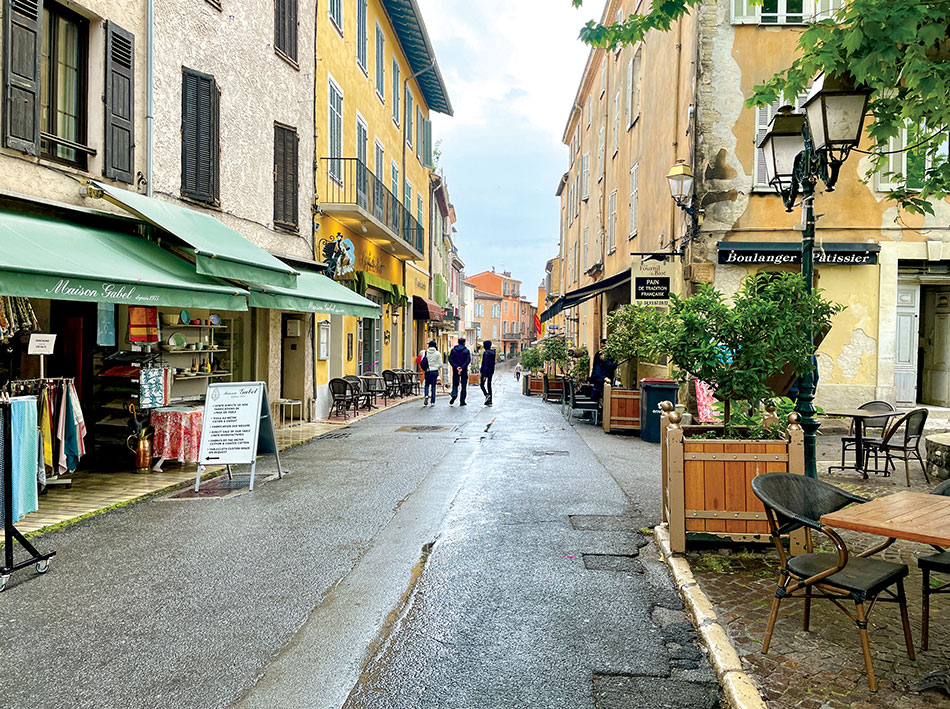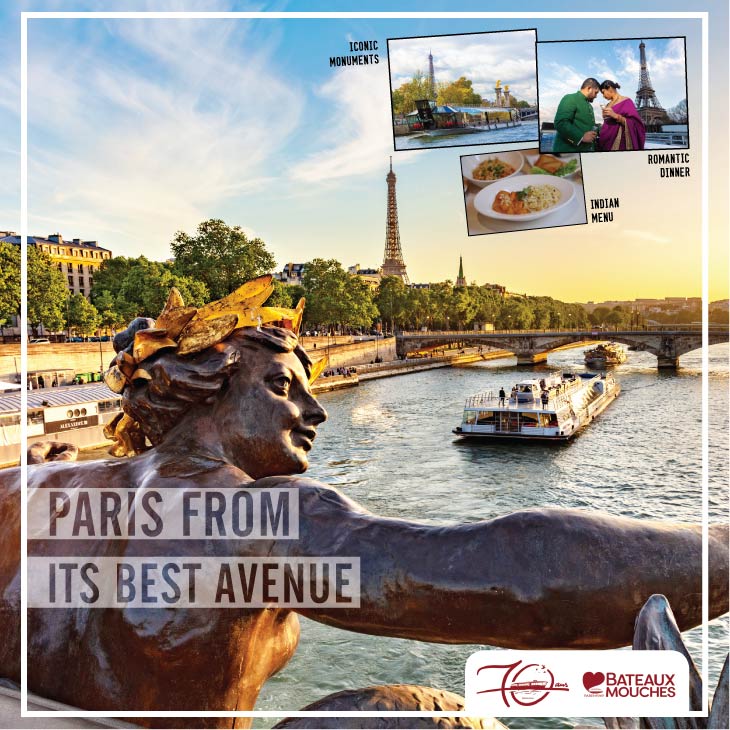
Port Vauban in Antibes is the largest leisure port in Europe (Photo: Pallavi Pasricha)
The deep blue Mediterranean Sea, white sand beaches, sunbathing and fiery sunsets – that’s the vision of the French Riviera I have. But instead, a dark cloudy sky and rain greeted me as I arrived. Being an optimist, I hoped that the weather would clear soon and I would get a glimpse of the crystal clear azure waters that I had been dreaming of, after all, this glamorous region is said to be drenched in nearly 300 days of sunshine. However, clouds also come with a silver lining, so I ended up seeing a double rainbow on my first evening. Usually people head to Nice and Cannes, but I was here to explore Antibes and Vence and the charming small villages that lie around in Côte d’Azur, another name for the French Riviera.
Arty Antibes
Antibes, the second largest city in the French Riviera, is home to more than 30 pristine beaches. Far more exclusive than Cannes or Nice, Antibes is a draw for the super-rich and famous for long, luxury yachts line Port Vauban, the largest leisure port in Europe that lies here. The understated glamour of Antibes is set against the backdrop of an ancient walled city that was once part of the Greek and Roman Empires, then independent for many centuries before joining France in the 15th century.
The signs of history lie all around. It is ringed by sturdy walls built for its defence that overlook the oh so blue Mediterranean Sea. The 16th century Fort Carré, made during King Henry II’s reign, resembles a four pointed star which made it possible to spot if an attack was coming from any direction.
Wandering around the town’s narrow cobbled alleys and the lively and colourful daily Provencal market where stalls sell everything from locally-grown olives to fresh cheese was a delight. What is even more impressive is the town’s artistic history as Antibes was where Spanish artist Pablo Picasso spent time drawing inspiration from its beauty. I headed out to Musée Picasso, housed in a former medieval castle, Chateau Grimaldi, where the artist came to work daily in 1946. On the top floor, which used to be his studio, I saw an impressive painting he made directly on the wall, doing away with the canvas. As I ambled along the museum galleries, I was struck by the vast range of his work, from drawings with simple charcoal and crayons to paintings created with industrial paint. The subjects vary from the city of Antibes to female figures, animals and food. He gave the museum 23 paintings and 43 drawings.

Antibes is home to Musée Picasso, housed in a former medieval castle, Chateau Grimaldi (Photo: Mairie d_Antibes)
A place where luxury and history combine
The hotel where I stayed encapsulated everything that Antibes stands for. Conceived in the mid 19th century as a retreat for artists and writers, Hotel du Cap-Eden-Roc has been around for more than 150 years. Resembling a picturesque castle, it is the summer playground of top Hollywood actors, artists, authors and politicians, from Clint Eastwood, Robert de Niro, Ernest Hemingway, Picasso, Churchill, the Kennedys to the Kardashians. Many of them have jumped from the rocks here straight into the sea which seems to wrap around the hotel. I was keeping my fingers crossed, hoping that I would spot someone rich and famous, but alas that didn’t happen.
During the hotel tour I learnt that it was during the first Cannes Film Festival in 1946 that it acquired its reputation. Its 111 suites and rooms are swanky yet brim with old world charm and the latest feather to its cap is a Dior spa. The restaurants overlook the sea and the heated pool set against the rocks is where all the action takes place, mainly when it’s a sunny day. What I particularly enjoyed, apart from the luxurious Dior spa treatment, was the hotel’s signature cocktail Bellini at the Bellini Bar. Made with white peach puree and peach liqueur, I couldn’t get enough of it.

Biot is a colourful hilltop village near Antibes (Photo: Pallavi Pasricha)
Villages around Antibes
When it was time to venture out, my first stop was the charming hilltop village of Biot. Driving along winding roads on a wet day past an olive tree-lined landscape, I reached this colourful village dotted with yellow, peach and orange buildings. My guide told me that there are about 1,000 inhabitants in the main village area. Biot, which used to be frequently attacked by pirates, was rebuilt by Italians in the 15th century and hence there’s an Italian touch everywhere.
Through its narrow, cobbled streets, I passed by souvenir stores, patisseries, chocolateries and cafes to reach the village centre. In its oldest streets, houses are packed close to each other along narrow passageways. The heavy rain prevented me from exploring the entire village but there are guided tours for travellers.
Once famed for pottery and ceramics, Biot is now known as the modern glass capital of the world. I visited a couple of glass factories including its first one, La Verrerie de Biot, which dates back to 1956. Watching the glassblowers work with unwavering concentration and precision is an eye opener.
Next in line was a town named Vallauris, once known as the city of potters and home to many famous artists. Picasso’s stamp is visible here also. At the art gallery of Agnes Sandahl, a famous painter and ceramist, I saw a ceramic plate that he made in 1956.
My encounter with Sandahl gave me a glimpse into how art is created. After showing us her gallery and the oldest wood oven dating back to the 1850s that was used by many artists, she turned on the peppiest French music and started swaying to those tunes, saying that this is her inspiration. Her art work and ceramics are now part of the two Oetker Collection hotels in the French Riviera.
Vence and Saint Martin de Vence
As I tucked into bed each night in my lavish suite at Hotel du Cap-Eden-Roc, I wondered who else had stayed in the same room. Could it have been a famous actor or writer? While saying goodbye to this hotel and Antibes was hard, but my next destination was equally gorgeous.
Vence is a quaint medieval town tucked away in the hills with fountains, cobbled stone pathways and structures that go back many centuries.
At the Chateau Saint-Martin & Spa where I checked in, I got gorgeous views of the hills on one side and the Mediterranean Sea on the other from my room. It could not have been better. This hotel is home to a Michelin star restaurant, Le Saint-Martin and a gourmet lunch at the terrace overlooking the hills and sipping wine fulfilled my picture perfect vision of life in the French Riviera.
A tour of the massive underground cellar, one of the oldest in France revealed how seriously this hotel takes its wine. It was stacked with endless rows of wine bottles, not just from France but also other countries, with the most expensive one costing a mind-boggling EUR 7,000. The hotel organises wine tasting and pairing as well for its guests.
To help digest a dreamy lunch, I headed to one of the most charming medieval villages I have ever seen Saint Paul de Vence that is perched on a hilltop. Walking along the narrow streets of this picturesque, fairy-tale like village strewn with flower beds, I understood why it is a haven for artists. I walked along a 16th century fort wall to reach a stunning viewpoint from where my eye wandered from the Mediterranean Sea to the lush green hills of Malvan valley. In the distance, I could even spot the snow-capped peaks of the Maritime Alps.
Art is the soul of Saint Paul de Vence. Here, in the Folon Chapel, I saw a stunning mosaic wall depicting the village. Created by Belgian artist Jean-Michel Folon with more than 1 million pieces, it was unlike anything I had seen.
The tiny village is home to about 40 galleries and workshops. At Bang & Lessin Art, an open atelier by a couple Louise Bang and Gui Lessin, I was impressed with their colourful collection of paintings, but even more impressed to watch Gui at work.
He brought out a white canvas, and palette in hand, started painting right on the street. It was delightful to see him transform the canvas and do what his heart desired. It took me back to the time when I experimented with doing the same and that painting is now hanging in my home. I had the sudden urge to also experiment on canvas and took a vow to do so when I got back home.
In a country and a region famous for its perfumes, how could I not visit a perfumer? My stop was at Sonia Godet, who has been running an over century-old family business and makes perfumes with the most natural ingredients and flowers that abound in the region. Sampling the fragrances she had created was a rare treat.
Whether it was Vence or Antibes, my tryst with the French Riviera made me realise how effortlessly it combines glitz and glamour with history, art and culture.

















